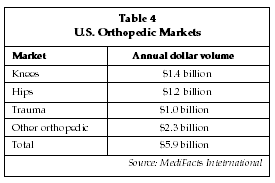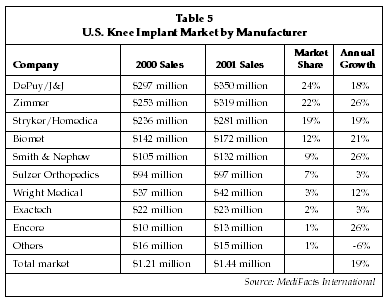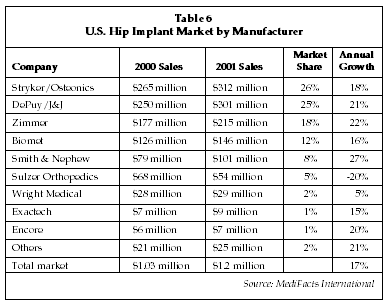BBI Contributing Editor
In the 1980s, orthopedics was considered one of the great growth markets of medical devices. Double-digit unit growth was commonplace, even expected with casual anticipation. Price increases were largely unconstrained — often in high single digits annually. New technology, and the accompanying higher prices, were accepted by hospitals and third-party payers as "normal." The middle and late 1990s were a different story, however. Unit growth diminished to 1% to 4% per year, while pricing increases were nominal and often eliminated by deeper discounts to hospitals. Technological improvements also slowed as product life cycles were extended longer than in the glory days.
Now, after almost a decade of relatively lackluster demand, the market for orthopedic joint and trauma implants has seemingly returned to high growth status. The industry consolidation experienced in the latter part of the 1990s has either initiated, or benefited from, a higher product demand for orthopedic implants. Table 4 shows the size of the relative U.S. market segments, with knee implants leading the way with sales of $1.4 billion. Hip implants and trauma implants also provide more than $1 billion dollar market segments.
 |
Knee implants
As the largest orthopedic market in dollar terms, knee implants also is one of the fastest-growing sectors. With an astounding 19% growth for last year over 2000, this segment has proven exciting. This incredible growth follows an already successful 2000 where the composite market grew at almost 10% (Table 5).
 |
DePuy (Warsaw, Indiana), now a subsidiary of Johnson & Johnson (New Brunswick, New Jersey), saw its market leadership position remain at just over 24% of the U.S. knee market, growing at 18% over 2000 sales. DePuy combined with Johnson & Johnson Orthopedics (Raynham, New Jersey) in late 1999, making the new firm one of the largest orthopedic companies, close to the level of Stryker (Kalamazoo, Michigan) after its acquisition of Howmedica (Rutherford, New Jersey).
Zimmer (Warsaw, Indiana), the No. 2 supplier in the segment was even more successful, while growing at 26% on U.S. sales of $319 million dollars. After two years of being available for sale by parent Bristol-Myers Squibb (New York), Zimmer was finally allowed to go solo after an initial public offering. The company's newfound independence has been successful following almost a decade of losing market share in implants.
The merger of Howmedica and Stryker's Osteonics division (Allendale, New Jersey) created an entity that nearly equals the DePuy/J&J merger. Naming the new division has created some confusion, however, with its Howmedica Osteonics moniker. Howmedica generated U.S. knee sales of $281 million in 2001, but the division's commendable 19% growth only allowed it to maintain its nearly 20% market share. Like the behemoth DePuy-J&J merger, combining the efforts to these two disparate corporate personalities was a challenge, but one that occurred without an apparent hitch, at least externally.
Biomet (also Warsaw), the No. 4 provider of knee products, remains solo in its competitive spirit. Five of Biomet's top eight competitors from just four years ago have merged with others or changed their corporate affiliation. Biomet simply continues gaining market share without benefit of major corporate changes. With U.S. knee sales of $171 million in 2001, Biomet controls almost 12% of the market.
Smith & Nephew Orthopedics (Memphis, Tennessee) also continues to gain share without benefit of acquisitions or mergers. Tied for the highest growth rate in the segment for 2001, the company grew at 26% for sales of $131, or a 9% market share. Smith & Nephew has benefited from the upgrade of the Genesis knee to the Genesis II, and success of its Profix knee system. Other important competitors within the knee segment include Sulzer Orthopedics (Austin, Texas), Wright Medical (Memphis, Tennessee), Exactech (Gainesville, Florida) and Encore Orthopedics (Austin, Texas), each with less than 7% market share in 2001.
Hip implants
Traditionally considered a more mature market than knee implants, hip sales were nonetheless dramatic in 2001. The U.S. market increased at a 16.5% rate to $1.2 billion for the year. Following a 10% increase in 2000, these two recent successful years follow a decade of nearly stagnant sales. As with knees, the hip segment had mid- to high-single-digit price increases coupled with high-single-digit unit growth. The remainder of the growth experienced were from product mix changes (particularly to the more expensive metal-on-metal articulating surface designs and from a lessening of discounting.
There is a continuing trend toward porous implants and away from uncoated or cemented stems. The two fixation methods are almost equal in units, although the higher price of porous implants make dollar sales of porous implants 40% greater than that of cemented implants. This represents a continuous trend that is not expected to change in the near future.
Howmedica Osteonics leads in hip sales for the third consecutive year. The company had sales of $312 million, although its 17.9% growth rate was not as great as its nearest competitors, DePuy and Zimmer. Stryker Osteonic's Secure-Fit Hip accounted for almost half the firm''s hip sales. Beyond this successful brand, the company provides a large number of niche products to generate its leading sales position.
 |
DePuy is a close second in hip sales with $300 million. The year 2001 was very successful for DePuy as sales increased to 20.5%. The DePuy product offering is based on the SROM and AML brand products. The SROM hip system, including stems, heads, cups and liners, provided nearly 35% of all the company's hip sales. AML stems accounted for only 20% of hip sales, but when combined with the Prodigy stem (a similar design), the Duraloc cup, liners and femoral heads for a complete system, AML sales far outdistance that of the SROM brand.
As with knee implants, Zimmer had an extremely successful year in hips after many years of losing share. With growth of 22%, Zimmer generated sales of $215 million for 2001. The Versys brand stem, coupled with the Trilogy cup, provided most of that sales volume. Zimmer also leads the market in the sales of endoprosthesis and bipolar heads combined. These products target the hip fracture market for hip replacement in the elderly who have fallen and can't get up.
During 2000, Zimmer reached an agreement to distribute the products of Implex (Allendale, New Jersey). a small but emerging company with a unique porous surface used with its implants.
Biomet mirrors its No. 4 knee market position in hips. With sales of $146 million, Biomet has room to grow but held market position with 16% growth in 2001. Currently relying on the Maxim knee design, Biomet has taken market position continuously over the past decade since its startup in the 1980s.
Smith & Nephew Orthopedics fills the No. 5 market position with sales of $100 million, or an 8% market share. The Synergy hip stem and Reflection cup are the company's most popular hip brands.
Sulzer Orthopedics had a difficult year in hip sales in 2001, with sales declining almost 20% from 2000. Sulzer's problems originated with the fracture of several ceramic cups, necessitating revision surgery in those patients. The firm was not only faced with a product recall of ceramic heads, but also with numerous lawsuits. Sulzer probably avoided potential disastrous financial claims by getting all claims consolidated into a single class-action lawsuit. While the results will likely result in heavy financial penalties, the consolidation of claims may have avoided bankruptcy for the company. Given the nature of the bad press and litigious atmosphere, Sulzer probably survived 2001 as well as possible. Wright Medical, Encore and Exactech are other important providers of hip implants in the U.S., with a combined sales volume approaching $50 million.
Orthopedic issues
Despite the rapid market growth, the orthopedic implant industry faces several important issues in the near future. Whether the industry can face these challenges will determine the success of the past two years can continue for a decade or longer, or that these two years were simply aberrations in a slow-growth industry. Some of these issues:
Medicare reimbursement. More than 60% of all joint replacement patients are covered by Medicare health insurance. In an effort to contain rising Medicare costs, the U.S. government has not appreciably increased hospital reimbursement for joint replacement surgery (primarily DRG 209) over the past decade. Indeed, the year 2001 saw a decline of 1% for such operations. While hospital reimbursements were mostly flat over the last decade, joint implant prices have nearly doubled. Over the last 10 years, the cost of an implant has risen from 20% of the total hospital cost of doing joint replacement surgery, to 40% and even 50% today. Likewise, surgeon fees have dropped by 20% to 25% over the same time period. As a result of rising implant prices, hospitals have been required to reduce costs through other methods, such as reducing patient stay periods. In some cases, hospitals have been forced to lose money for joint replacement surgeries. At some point, hospitals will address the issue of profitability of joint replacement surgery, or even reduce the number of such surgeries. When hospitals refocus their attention on the issue of that surgeries costs, it is unclear whether the current price increases and unit growth rates can continue.
Consolidation. The period of industry consolidation appears to be largely complete, at least for now. During periods of slower growth, manufacturing management turns their attention from product development to acquisition/merger as a means of gaining market share. More likely consolidations may take place today in the name of technology acquisitions rather than manufacturing or distribution driven mergers. With companies again focusing on product development, any new technological evolution available from smaller firms will immediately become targets for the larger players.
Materials/wear debris. The most pervasive product issue facing hip and knee manufacturers is wear debris from the articulating surfaces. When metal rubs against polyethylene articulating surfaces, a very small level of wear debris is released. With a typical knee or hip articulating a million or more times per year, eventually the wear debris becomes measurable. Any accumulation of wear particles in the articulating surface can increase the rate of particulate failure. Even more importantly, debris that migrates into the implant to bone interface can cause eventual implant failure. Companies are looking at both materials and product design to minimize wear debris. If one company can move dramatically ahead in the race for wear particle reduction, they will likely gain a significant competitive advantage and therefore increase market share. Two materials being seriously investigated are ceramic-on-ceramic and metal-on-metal articulating surfaces. Both materials have the advantage of a decreased volume of wear debris, but skeptics point out that the number of wear particles remain the same or are even higher. Due to the smaller wear particle size, the overall wear particle volume is reduced. It is currently unclear if the particle volume generates implant failure, or if the number of wear particles does so.
Ceramic head failure lawsuits. Sulzer Orthopedics, one of the companies searching for methods to reduce wear debris, became a leader in combining ceramic heads and ceramic liners in its hip product offering. Unfortunately for Sulzer, the incidents of ceramic fracturing in patients are statistically higher than for non-ceramic implants. Sulzer is striving to overcome both the negative publicity and the financial burdens of those failures.
Other companies looking for solutions may find similar or even new problems with their product improvements. At some point, the risk-reward relationship may make it difficult to find a solution to this and other product problems.
It is doubtful that the orthopedic industry will continue the high level of growth seen in 2001, or even the level generated in 2000. Given the constraint on reimbursement levels for the majority of implant patients, price increases of more than 2% to 4% will be met with resistance at some point. Likewise, unit increases are probably tied to the Baby Boomer generation as that group enters the over-60 age group. Boomers are not there yet, but even when they arrive, low single-digit increases appear more likely than the 10% rates seen recently.
